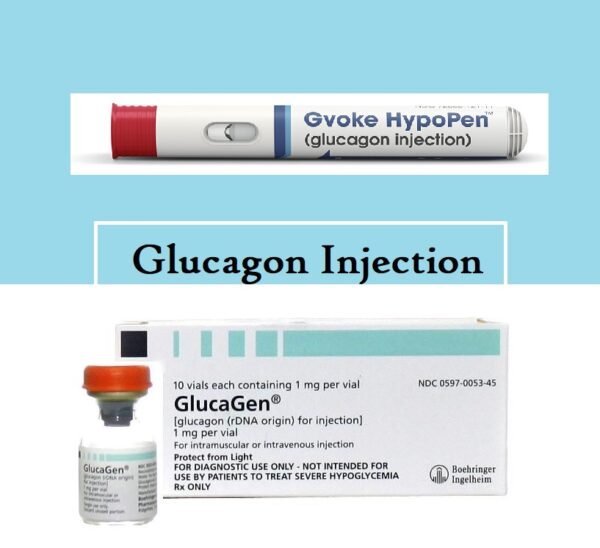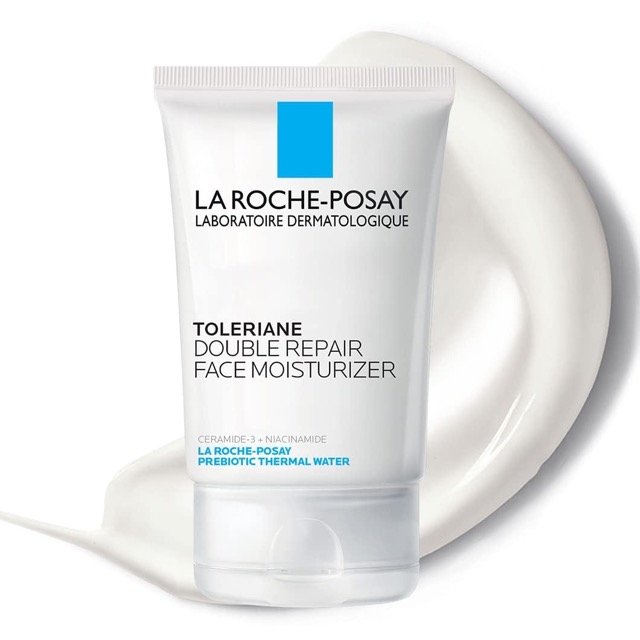Glucagon is a pancreatic hormone produced by the alpha cells of the pancreas. It is available as injections for intramuscular and intravenous use to treat refractory hypoglycemia, beta-blockers, and calcium-channel blocker toxicity (refractory to epinephrine), and as a diagnostic agent.
Indications of Glucagon:
-
Diagnostic aid:
- During radiologic examinations, it is used as a diagnostic tool as it temporarily inhibits movement of the GI tract in adults.
-
Hypoglycemia:
- Used to treat both adult and paediatric patients with severe hypoglycemia.
- Note: According to the ADA, all diabetic individuals at risk of level 2 hypoglycemia (less than 54 mg/dl) should be prescribed glucagon. On when and how to administer glucagon, caregivers, educators, or family members of such people should receive training.
- Restrictions on use: The emergency treatment of hypoglycemia is not suggested for products that are not provided with a syringe and diluent necessary for quick preparation and administration during an emergency outside of a healthcare facility.
-
Off Label Use of Glucagon in Adults:
- Anaphylaxis
- Beta-blocker overdose
- Calcium channel blocker overdose
Glucagon dose in adults:
Glucagon dose as a diagnostic aid:
-
Relaxation of the stomach, duodenal bulb, duodenum, and small bowel:
- IM: 1 mg.
- IV: 0.2 to 0.5 mg.
-
Relaxation of colon:
- IM: 1 to 2 mg.
- IV: 0.5 to 0.75 mg.
Glucagon dose in the treatment of Hypoglycemia:
- IM, IV, SubQ: 1 mg; may be repeated in 15 minutes as required.
- Intranasal: three milligrammes (one actuation) into one nostril (the dose may be repeated in 15 minutes)
- Note: Administer IV dextrose as soon as it is available; if there is no response to glucagon, must give IV dextrose.
Glucagon dose in the treatment of Anaphylaxis (refractory to epinephrine) in patients on beta-blocker therapy (off-label):
- IV: Initial: 1 to 5 mg bolus, then 5 to 15 mcg/minute of infusion; the infusion rate should be adjusted to produce an appropriate clinical response.
Glucagon dose in the treatment of Beta-blocker overdose (off-label):
- IV: 3 to 10 mg bolus; if no clinical response, repeat the bolus dosage; if there is a clinical response to the bolus dose, start the continuous infusion at 3 to 5 mg/hour; titrate the infusion rate to reach the desired hemodynamic response.
Glucagon dose in the treatment of Calcium channel blocker overdose (off-label):
- IV: 3 to 10 mg bolus; if no clinical response occurs, the bolus dose may be repeated; if a clinical response occurs, the continuous infusion should begin at 3 to 5 mg/hour;
Glucagon Dose in Childrens
Glucagon Dose in the treatment of severe Hypoglycemia:
-
Weight-directed dosing:
-
Manufacturer's labeling:
- Infants, Children, or Adolescents weighing less than 20 kg:
- Glucagon: IM, IV, SubQ: 0.02-0.03 mg/kg.
- max dose: 0.5 mg
-
Alternate dosing:
- Infants, Children, and Adolescents:
- AAP: IM, IV, Subcutaneous: 0.03 mg/kg; max dose: 1 mg.
- IDF-ISPAD: IM, Subcutaneous: 0.01-0.03 mg/kg; max dose-dependent on age: <12 years: 0.5 mg; ≥12 years: 1 mg.
- Infants, Children, and Adolescents:
-
-
Fixed dosing; age-directed:
-
Manufacturer's labeling: GlucaGen: IM, IV, SubQ:
- Infants and Children <6 years: 0.5 mg
- Children and Adolescents ≥6 years: 1 mg
-
Alternate dosing: IM, Subcutaneous:
-
IDF-ISPAD (IDF-ISPAD, 2011):
- Infants and Children <12 years: 0.5 mg
- Children and Adolescents ≥12 years: 1 mg
-
CDA (Canadian Diabetes Association, 2013):
- Infants and Children ≤5 years: 0.5 mg
- Children and Adolescents >5 years: 1 mg
-
-
-
Fixed dosing; weight-directed:
-
Infants, Children, and Adolescents:
-
Manufacturer's labeling: IM, IV, SubQ:
-
Glucagon: Patient weight:
- <20 kg: 0.5 mg
- ≥20 kg: 1 mg
-
GlucaGen: Patient weight:
- <25 kg: 0.5 mg
- ≥25 kg: 1 mg
-
-
-
Glucagon dose for the prevention of Hypoglycemia, during illness (fixed dosing, mini-dose): SubQ:
Note: These doses are lower than those used to treat hypoglycemia, and they have been demonstrated to prevent hypoglycemia for several hours in conditions like gastroenteritis and nausea/vomiting that are linked to hypoglycemia.
-
Infants and Children <2 years:
- 0.02 mg.
-
Children and Adolescents 2-15 years:
- 0.01 mg per year of age.
-
Adolescents >15 years:
- 0.15 mg.
Glucagon dose for the treatment of Beta-blocker or calcium channel blocker toxicity/overdose:
-
Infants and Children: Limited data available : IV:
- Loading dose: 0.03-0.15 mg/kg.
- Continuous IV infusion: 0.07 mg/kg/hour; max rate: 0.5 mg/hour.
-
Adolescents: IV:
- Loading dose: 5-10 mg over several minutes.
- Continuous IV infusion: 1-5 mg/hour.
Pregnancy Risk Category: B
- During animal reproduction studies, there were no adverse events.
Glucagon use during breastfeeding:
- Breastfeeding infants are less likely to experience side effects because glucagon is not absorbed through the GI tract.
Dose adjustment in renal disease:
No dosage adjustments are provided in the manufacturer’s labeling.
Dose adjustment in liver disease:
No dosage adjustments are provided in the manufacturer’s labeling.
Side Effects of Glucagon:
-
Gastrointestinal:
- Nausea (With Rapid Administration Of High Doses)
- Vomiting (With Rapid Administration Of High Doses)
-
Cardiovascular:
- Hypotension (Up To 2 Hours After GI Procedures)
- Increased Blood Pressure
- Increased Pulse
-
Dermatologic:
- Skin Rash
-
Hypersensitivity:
- Anaphylactic Shock
- Hypersensitivity Reaction
-
Respiratory:
- Dyspnea
Contraindications to Glucagon:
- Hypersensitivity to glucagon, lactose or any other component of the formulation
- Pheochromocytoma
- Insulinoma
- Glucagonoma (excluding GlucaGen)
Warnings and precautions
-
Hypersensitivity reactions
- Allergic reactions to glucagon have been reported and are usually associated with endoscopic patients
- These reactions include anaphylactic shock and skin rash (with hypotension or respiratory problems).
-
Necrolytic migratory Erythema:
- Necrolytic migratory Erythema (NME) is rarely reported after continuous glucagon injections.
- This cutaneous disease is frequently linked to glucagonomas (glucagon producing tumors). Erythematous bullae and plaques are its defining features.
- It can affect the face, legs, groin, perineum and legs.
- NME can lead to serious side effects. You should consider all options.
-
Insufficiency of the adrenals:
- Patients with adrenal insufficiency should be cautious as the glucose stores in their liver may be reduced.
-
Cardiac disease
- Be careful.
-
Hypoglycemia chronic:
- Patients with hypoglycemia should be cautious as the liver glucose stores can be reduced.
-
Diabetes:
- Use it as a diagnostic tool for diabetics on insulin.
-
Glucagonoma
- Be careful.
- Patients with this condition (except GlucaGen) are not advised to use glucagon.
-
Insulinoma
- Blood sugar levels may increase as a result of exogenous glucagon, followed by rebound hypoglycemia.
- Patients with this condition should not take glucagon.
-
Pheochromocytoma:
- Catecholamines may be released by exogenous glucagon, raising blood pressure.
- Patients with this condition should not take glucagon.
-
Fasting and starvation:
- Keep in mind that prolonged fasting or starvation may result in the depletion of hepatic glycogen.
Glucagon: Drug Interaction
|
Risk Factor C (Monitor therapy) |
|
|
Anticholinergic Agents |
May intensify Glucagon's negative or hazardous effects. Particularly, there may be a higher chance of unfavourable gastrointestinal consequences. |
|
Antidiabetic Agents |
The therapeutic benefit of anti-diabetic agents may be reduced by hyperglycemia-associated agents. |
|
Indomethacin |
May reduce Glucagon's therapeutic impact. |
|
Vitamin K Antagonists (eg, warfarin) |
The anticoagulant action of Vitamin K antagonists may be increased by glucagon. |
Monitoring parameters:
- Bp
- Heart rate
- Blood glucose levels
- Electrocardiogram
- Mentation
- Signs or symptoms of a hypersensitivity reaction.
How to administer Glucagon?
Diagnostic aid:
- For administration by IM or IV. Administering intravenously should take more than a minute.
- If it is appropriate given the diagnostic process used, patients who have been fasting should be given oral carbohydrates after the diagnostic procedure. Bolus intravenous dosages more than 1 mg are not advised.
Hypoglycemia:
- Upper arms, thighs, or buttocks may be used as injection sites for intravenous, subcutaneous, or intramuscular injections. Fast and long-acting oral carbohydrates should be administered to the patient as soon as feasible following the response to treatment.
IV:
- Rapid intravenous injection may cause nausea and vomiting; the patient should be positioned in a lateral recumbent position to protect the airway and prevent choking when consciousness returns.
- Patients on beta-blockers should get an IV bolus over a 5-minute period if they experience epinephrine-refractory anaphylaxis.
Beta-blocker/calcium channel blocker toxicity:
- Give a IV bolus over 3 to 5 minutes; consider using continuous infusions.
Mechanism of action of Glucagon:
- Stimulation of adenylate cyclase results in an increased production of cyclic AMP.
- This causes hepatic glucose to rise and gluconeogenesis.
- The stomach, duodenum, and small bowel's smooth muscles can relax as an extrahepatic impact.
The onset of action: Blood glucose levels:
- Peak effect seen with IV administration is 5 to 20 minutes with IM is 30 minutes and with subcutaneous administration, it is 30 to 45 minutes.
Duration:
- It takes 60-90 minutes for glucose elevation with IV, IM, SubQ injection.
- GI relaxation occurs in 9-25 minutes with IV and in 12-32 mins in case of IM injection.
Metabolism:
- The liver is the primary site, with kidneys and plasma also experiencing some inactivation.
Half-life elimination,
- The plasma half-life is 8-18 mins in case of IV and 26-45mins in case of IM injection
Time to peak:
- Almost 10-12.5 mins in IM and 20 mins in case of subcutaneous injection.
International Brand Names of Glucagon:
- GlucaGen Diagnostic
- GlucaGen HypoKit
- Glucagon Emergency
- Garcon
- Glucagen
- GlucaGen
- Glucagen G
- Glucagen Novo
- Glucagon Novo Nordisk
- R-Glucagon Lil
Glucagon Brand Names in Pakistan:
No Brands Available in Pakistan.







